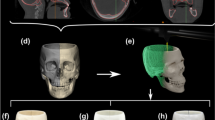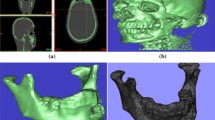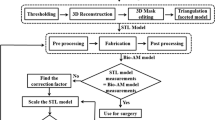Abstract
The skull is a complex structure and multidimensional in nature, so for surgeons operating skull injuries is a difficult. In recent years, Additive Manufacturing is popularly known as 3D printing technology where objects can be produced in 3 dimensional formats is playing a vital role in biomedical field and especially in complex surgeries. 3D printing technology helps the surgeon to visualize the injuries on a 3D physical model. The aim of this research work is assessment of dimensional accuracy of reproducibility of cadaver skull by FDM additive manufacturing process. In this paper a cadaver skull is subjected to 3D scanning, the scanned data is obtained in .STL format. This file is then imported into Simplify 3D software which is 3D printing machine interface software for printing skull. The skull is 3D printed using Fused Deposition Modelling (FDM) 3D-Printing process. To assess the dimensional accuracy of 3D printed skull, fixed land marks are taken on cadaver and 3D printed skull with reference to standard journal. These land marks are divided into four regions (craniofacial, mid face, orbital, skull base). The distance between land marks are measured by Digital Vernier Calipers. These measurements help in assessing the dimensional accuracy of cadaver skull with 3D printed skull.
Access provided by Autonomous University of Puebla. Download conference paper PDF
Similar content being viewed by others
Keywords
1 Introduction
Additive Manufacturing is a technology that build 3D objects by adding layer-by-layer of material, whether the material is metal, plastic, human tissue or concrete. Additive Manufacturing technology uses a computer 3D modelling software to create CAD model. Once a CAD model is completed, the Additive Manufacturing equipment reads data from the CAD file and lays downs successive layers of liquid, powder, solid material or other, in a layer-by-layer to produce a 3D model. In most cases, Additive manufacturing is applied for the fabrication of hard tissue parts of human body. The widely reported application of Additive Manufacturing is bio modeling of surgical planning in the field of maxillo-craniofacial surgery, which involves in surgical treatment of acquired deformations or congenital (e.g., trauma defections or tumor resections) both for aesthetic and functional purposes.
Literature Review
Chang et al. [1] described how stereolithographic can is used to generate physical models of the craniofacial model from three dimensions computed tomography (CT) scan data. Siva Rama Krishna et al. [2] evaluated zygomatic complex fractures based on three point fixation technique using additive manufacturing process. By adapting this methodology, it is possible to evaluate i.e. calculate the percentage of the Zygomatic Bone restored after Operation. Smith et al. [3] illustrate the accuracy of bone surface reconstruction of two diarthrodial joints, the hip and shoulder, from CT scan data. Image segmentation of the tomographic series was used to develop a three-dimensional virtual model, which was fabricated using fused deposition modeling. Giannatsis and Dedoussis et al. [4] reviewed the application of Additive manufacturing technologies in medical and health care. In the present paper, representative case studies from the field of AM medicine applications were presented and discussed. The case studies included applications like scaffolds for rehabilitation and fabrication of custom implants, models for pre-operating anatomical and surgical planning. Olszewski et al. [5] evaluated the use Additive Manufacturing in association with a different type of applications in CMF surgery. Muller et al. [6] discussed the application of Additive Manufacturing techniques in craniofacial reconstruction and preoperative planning of neurosurgery.
2 Problem Statement
The aim of this work is to assess the dimensional accuracy of FDM 3D printing process for reproducing Cadaver skull. For that a Cadaver skull is to be scanned to get an output of. STL file. The STL file is then transferred to FDM 3D printing machine to 3D print the skull. Then the distance between fixed landmarks are measured on Cadaver skull and 3D printed skull using digital vernier callipers. The obtained results are tabulated and evaluated to find out the dimensional accuracy.
3 Research Methodology
3.1 Collecting of Cadaver Skull
The Cadaver skull is collected from Dr. Suresh, CranioMaxillo Facial Surgeon, Sunshine Hospitals, Secunderabad. Figure 1 illustrates Cadaver skull.
3.2 Scanning Cadaver Skull Using Einscan pro+
Scanning of Cadaver skull is done through Einscan pro+ scanner at Think 3D Somajiguda, Hyderabad. The cadaver skull is placed on Einscan platform. The Einscan scans cadaver skull on platform. The platform rotates during scanning the data is collected in computer and save the file. STL. Scanning and capturing the data of cadaver skull is shown in Fig. 2.
3.3 3D Printing of Skull Using FDM Process
The STL is obtained from scanning is imported to flashprint software to remove excess portion and produce tree support structures. Then file imported into simplifier 3D software which is machine interface software for adjusting of layer thickness, infill percentage, selection of extruder and platform temperature. The model is printing on AHA 3D printer at IIT Hyderabad. Aha 3D printing machine which produces parts by Fused Deposition Modeling (FDM) process. The material Acrylonitrile Butadiene Styrene (ABS) is used for printing. Figure 3 illustrates Aha 3D FDM machine (Fig. 4).
4 Results and Discussions
4.1 Fixed Landmarks on Skull
For analysis, dimensions of the overall measurements were organized into five groups. This representing different regions: skull base, craniofacial, orbital, midface, and maxilla. Figure 5 shows fixed Landmarks on the skull [1].
Dimensions used to compare Cadaver and 3D printed skull for overall measurements by group (*bilateral measure). AFM, anterior foramen magnum; AAl, anterior alveolus; ANS, anterior nasal spine; In, inion; IoT, inferolateral orbit transition; IoF, infraorbital foramen; LFM, left foramen magnum; LZsF, lateral zygomaticofrontal Suture; LPA, lateral piriform aperture; Mo, Medial Orbit; Na, nasion; MP, mastoid process; PAI, posterior alveolus; Po, porion; PFM, posterior foramen magnum; RMF, right foramen magnum; ZfS, zygomaticofrontal Suture; SoF, supraorbital foramen; ZyP, zygomatic prominence.
4.2 Measuring of Cadaver Skull
The displacements between fixed land marks are measured for Craniofacial region (Fig. 6).
The displacements between fixed land marks are measured for skull base region (Fig. 7).
The displacements between fixed land marks are measured for orbital region (Fig. 8).
The displacements between fixed land marks are measured for midface region (Fig. 9).
4.3 Measuring of 3D Printed Skull
The displacements between fixed land marks are measured for Craniofacial region (Fig. 10).
The displacements between fixed land marks are measured for skull base region (Fig. 11).
The displacements between fixed land marks are measured for orbital region (Fig. 12).
The displacements between fixed land marks are measured for midface region (Fig. 13).
4.4 Distance Between Land Mark Points of Cadaver and 3D Printed Skull
The distance between landmarks on cadaver and 3D printed skull are measured for four region and illustrated in Tables 1, 2, 3 and 4.
4.5 Considering Mean, Maximum and Minimum
The overall mean, maximum and minimum deviation for cadaver and 3D printed skull in four regions are illustrated in Table 5.
5 Conclusions
The aim of this project is to compare the dimensional accuracy of FDM 3D printed skull with Cadaver skull. The displacement between fixed marks on skulls with respect to four regions are measured and compared. The mean overall difference between FDM 3D printed skull and Cadaver skull is ranging from 0.2 to 0.5 mm and percentage error is less than 1.6% for all regions. The maximum error in overall regions is 1.2 mm and maximum percentage error of 2.1% is observed in midface region. The percentage error in orbital and midface is higher than craniofacial and skull base regions. The maximum errors observed in midface dimensions, which is subjected to less precision in modelling, thin surfaces and small projections found in midface region. This errors occurs due to insufficient support structures on thin areas and shrinkage, during data preparation and transfer. This problems can be reduced by enhancement of 3D printing software’s, hardware and material.
References
Chang PS-H, Parker TH (2003) The accuracy of stereolithography in planning craniofacial bone replacement. J Craniofac Surg 14(2):164–170
Siva Rama Krishna L, Vemulakonda BS, Potturi A (2018) Evaluation of zygomatic complex fractures based on three point fixation technique using additive manufacturing. Int J Sci Res Sci Technol 4(2):1092–1100
Smith EJ, Anstey JA, Venne G, Ellis RE (2013) Using additive manufacturing in accuracy evaluation of reconstructions from computed tomography. Part H: J Eng Med 227(5):551–559
Giannatsis J, Dedoussis V (2009) Additive fabrication technologies applied to medicine and health care: a review. Int J Adv Manuf Technol 40(1–2):116–127
Olszewski R, Reychler H (2004) Clinical applications of rapid prototyping models in cranio-maxillofacial surgery. In: Advanced applications of rapid prototyping technology in modern engineering
Müller A, Krishnan KG, Uhl E, Mast G (2003) The application of rapid prototyping techniques in cranial reconstruction and preoperative planning in neurosurgery. J Craniofac Surg 14(6):899–914
Gerstle TL, Ibrahim A, Kim PS, Lee BT, Lin SJ (2014) A plastic surgery application in evolution: three dimensional printing. Plast Reconstr Surg: J Am Soc Plast Surg 133(2):446–451
Acknowledgements
The Authors would like to thank UGC, South Eastern Regional Office, Hyderabad, as this research is carried out as a part of UGC Minor Research Project titled “Assessment of Dimensional Accuracy of Facial (Zygomatic) bone fractures reduction using Additive Manufacturing: a Randomized Control Study” Proposal No. 1204, Letter No. F. No: 4-4/2015-16/MRP/UGC-SERO, Dt. Oct 2016 sanctioned to Dr. L. Siva Rama Krishna.
Author information
Authors and Affiliations
Corresponding author
Editor information
Editors and Affiliations
Rights and permissions
Copyright information
© 2020 Springer Nature Switzerland AG
About this paper
Cite this paper
Siva Rama Krishna, L., Balasany, U.K., Venkatesh, S.R., Potturi, A. (2020). Assessment of Dimensional Accuracy of Reproducibility of Cadaver Skull by FDM Additive Manufacturing. In: Satapathy, S., Raju, K., Molugaram, K., Krishnaiah, A., Tsihrintzis, G. (eds) International Conference on Emerging Trends in Engineering (ICETE). Learning and Analytics in Intelligent Systems, vol 2. Springer, Cham. https://doi.org/10.1007/978-3-030-24314-2_78
Download citation
DOI: https://doi.org/10.1007/978-3-030-24314-2_78
Published:
Publisher Name: Springer, Cham
Print ISBN: 978-3-030-24313-5
Online ISBN: 978-3-030-24314-2
eBook Packages: EngineeringEngineering (R0)

















